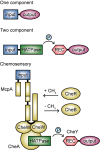Sensory Perception in Bacterial Cyclic Diguanylate Signal Transduction
- PMID: 34606374
- PMCID: PMC8846402
- DOI: 10.1128/JB.00433-21
Sensory Perception in Bacterial Cyclic Diguanylate Signal Transduction
Abstract
Cyclic diguanylate (c-di-GMP) signal transduction systems provide bacteria with the ability to sense changing cell status or environmental conditions and then execute suitable physiological and social behaviors in response. In this review, we provide a comprehensive census of the stimuli and receptors that are linked to the modulation of intracellular c-di-GMP. Emerging evidence indicates that c-di-GMP networks sense light, surfaces, energy, redox potential, respiratory electron acceptors, temperature, and structurally diverse biotic and abiotic chemicals. Bioinformatic analysis of sensory domains in diguanylate cyclases and c-di-GMP-specific phosphodiesterases as well as the receptor complexes associated with them reveals that these functions are linked to a diverse repertoire of protein domain families. We describe the principles of stimulus perception learned from studying these modular sensory devices, illustrate how they are assembled in varied combinations with output domains, and summarize a system for classifying these sensor proteins based on their complexity. Biological information processing via c-di-GMP signal transduction not only is fundamental to bacterial survival in dynamic environments but also is being used to engineer gene expression circuitry and synthetic proteins with à la carte biochemical functionalities.
Keywords: biofilms; cyclic diguanylate; diguanylate cyclase; phosphodiesterase; sensor domain; signal transduction; stimulus perception.
Conflict of interest statement
The authors declare no conflict of interest.
Figures





References
-
- Almblad H, Randall TE, Liu F, Leblanc K, Groves RA, Kittichotirat W, Winsor GL, Fournier N, Au E, Groizeleau J, Rich JD, Lou YF, Granton E, Jennings LK, Singletary LA, Winstone TML, Good NM, Bumgarner RE, Hynes MF, Singh M, Stietz MS, Brinkman FSL, Kumar A, Brassinga AKC, Parsek MR, Tseng BS, Lewis IA, Yipp BG, MacCallum JL, Harrison JJ. 2021. Bacterial cyclic diguanylate signaling networks sense temperature. Nat Commun 12:1986. 10.1038/s41467-021-22176-2. - DOI - PMC - PubMed
Publication types
MeSH terms
Substances
Grants and funding
LinkOut - more resources
Full Text Sources
Other Literature Sources

